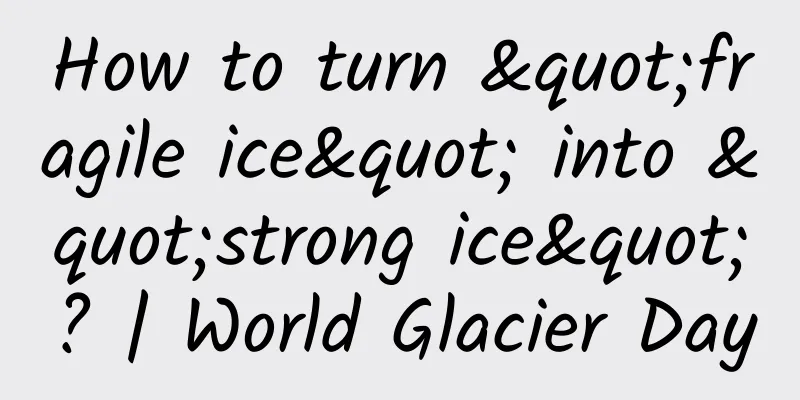How to turn "fragile ice" into "strong ice"? | World Glacier Day

|
On December 14, 2022, the United Nations General Assembly passed a special resolution declaring 2025 as the International Year of Glacier Conservation. From 2025, March 21 of each year will be designated as World Glacier Day. Faced with the accelerated melting of glaciers, scientists are worried and have launched actions to save the glaciers. Among them, a very interesting experiment - "covering the glaciers with a blanket" has attracted widespread attention. This does sound incredible. Can "covering the glaciers with a blanket" really slow down their melting? 01 The Past and Present of Glaciers "How do we know this is the Ice Age?" "Because there's ice all around!" "Even his words were cold." These are some dialogues between animals in the animated film "Ice Age". The gentle and kind mammoth, the fierce and domineering saber-toothed tiger, the talkative sloth, the stupid but very funny dodo, and the little squirrel who struggled for nuts all his life have left a deep impression on everyone. But what is the Ice Age like? Is it really full of joy and warmth? After all, the movie is a fictional story. The real Ice Age was actually very cruel. Many creatures gradually became extinct during this period of drastic climate change, such as giant beavers, Titan birds, and ancient monitor lizards. In the history of geological evolution, not only has the earth undergone changes in land and sea, but also has experienced drastic changes in climate. When the climate tends to be cold, the Antarctic, Arctic and high-latitude areas, as well as the plateaus and mountains in the middle and low latitudes will slowly be covered by ice sheets or glaciers. Such a geological period is called the "Ice Age". The "Ice all around" mentioned in the movie is the simplest explanation of the Ice Age. Mammoths in the Ice Age (copyrighted image; reprinting may cause copyright disputes) Our Earth has experienced many ice ages, among which the Quaternary Ice Age is the closest to the present and has the greatest impact. During the coldest period of this Ice Age, snow and hail often occurred, glaciers and icebergs were everywhere, and the average temperature was 3℃ to 7℃ lower than it is now. The land was covered by vast glaciers, and a large amount of water was "trapped" on the land, resulting in a drop in sea level of about 130 meters. Later, as the temperature gradually rose, the glaciers began to slowly melt, and the sea level gradually rose. It was not until about 6,000 years ago that the sea level was close to its current position. Glacier melting (copyrighted image, reprinting may cause copyright disputes) Although the Ice Age is gradually fading away, the glaciers have not completely disappeared. To date, there are still tens of thousands of glaciers distributed on the earth, preserving the geological relics and unique landforms left by the glaciers, forming a beautiful landscape. 02 Risk of global glacier melting Glaciers are extremely precious freshwater resources on Earth. We know that more than two-thirds of the Earth's surface is covered by water, with a total water volume of about 145 trillion tons, but only less than 3% of the land freshwater is available for human drinking, and most of this exists in the form of glaciers. Therefore, glaciers are known as "solid water reservoirs." According to the shape, size and development conditions of glaciers, modern glaciers can be divided into two basic types: continental glaciers and mountain glaciers . ♦Continental glaciers : The surface is convex and shield-shaped, thick in the middle and thin at the edges, and the thickest part can reach several thousand meters, such as the Antarctic ice sheet; Antarctic iceberg scenery (copyrighted image, reprinting may cause copyright disputes) ♦Mountain glaciers : They are widely distributed in mountainous areas around the world. They are usually small in area and thin in thickness, such as the many glaciers on the Qinghai-Tibet Plateau in China. Glacier No. 10 of Puruogangri Icefield in Shuanghu County, Nagqu City, Tibet (drone photo). Photo by Xinhua News Agency reporter Jiang Fan At the same time, glaciers are also an important external force in shaping topography. Modern glaciers cover 10.7% of the world's land surface. Glaciers exist on all seven continents except Oceania, and ancient glaciers were once everywhere. Although it moves as slowly as a snail, it can greatly change the surface environment over time, forming unique glacial landforms, such as deep glacial valleys, ridges with steep slopes and sharp and thin ridges like blades or sawtooth, rivers, lakes and alluvial plains formed by glacial meltwater, etc. In recent years, as the global climate warms, glaciers are also facing the threat of melting. The melting of glaciers is not just the disappearance of natural landscapes. They are the water source guarantee for 2 billion people, the "safety lock" to prevent coastal cities from being flooded, and the "regulator" of the earth's climate system. The white surface of glaciers can reflect 80% of sunlight back into space. Once the glaciers disappear, the exposed dark rocks and soil will absorb more heat, accelerating global warming and forming a vicious cycle. 03 Block the sun and keep the ice How can we stop the melting of glaciers? Scientists have found through long-term observation that the most direct way is to find ways to reduce solar radiation . Franz Josef Glacier, located in the South Island of New Zealand, is only 12 kilometers long, but it drops from 3,000 meters above sea level at its source to 240 meters at its end. Such a huge drop makes it the steepest glacier in New Zealand. Its average flow speed exceeds 0.5 meters per day, and can reach 4 meters per day at its fastest. What is even more strange is that in the context of global warming, other glaciers are shrinking, while Franz Josef Glacier has been slowly growing and thickening since 1984. As for the reason for the "counterattack" of Franz Josef Glacier, some experts believe that on the one hand, it may be due to the increase in snowfall in the Southern Alps , and on the other hand, it may be due to the eruption of nearby volcanoes, which sprayed volcanic ash into the atmosphere, blocking the sunlight, weakening the sunlight, and reducing the melting of the glacier. Inspired by this, people came up with a "homemade method" - "covering the glaciers with blankets". Since 2004, Swiss scientists have covered the glaciers in the Alps with white waterproof tarpaulins in late spring and early summer, and removed the tarpaulins in early autumn. The tarpaulins are made of chemical fibers and are 3 to 4 mm thick. Covering the glaciers with them can reflect sunlight to protect the ice and snow from heat and ultraviolet rays. Statistics show that this method can slow down the melting of ice and snow by 50%. Italian scientists also borrowed this "local method". The Presana Glacier is a famous ski resort, but the rapid melting of the glacier in recent years has had a certain impact on local tourism. Therefore, scientists proposed to lay giant rubber waterproof cloth on the glacier ski area to slow down the melting of the glacier. In Sichuan Province, my country, about 260 kilometers away from Chengdu, there is a Dagu Glacier that has a history of more than 2 million years. From 2020 to 2024, Chinese scientists have conducted experiments here for five consecutive years to cover the surface of the glacier with a layer of heat-insulating and reflective material. The experiments found that the "covered" glacier retreated slower than the surrounding areas that were not "covered". With the help of scientific researchers, the Dagu Glacier, which once melted rapidly, is becoming "ice strong". 04 Brainstorming to Save Glaciers Although the "covering with blankets" has achieved certain results in some areas, some scientists believe that this is an "unsustainable experiment". On the one hand, "covering with blankets" for glaciers requires a lot of manpower, material resources and financial resources, especially for those glaciers with large areas and complex terrains. It is not only expensive, but also very difficult to operate. It is even more unrealistic for giant ice sheets such as Greenland and Antarctica. On the other hand, the effect of "covering with blankets" for glaciers may also be affected by environmental factors. Under severe climatic conditions such as high altitudes and strong winds, the blankets can easily be blown away or damaged, and the protective effect on the glaciers will be greatly reduced. In addition to "covering the glaciers", scientists have come up with many other ways to save them. For example, some people consider that the bottom of marine glaciers will also melt due to the erosion of warm seawater, and simply "covering the glacier surface" will not help, so they propose to build "walls" underwater around the glaciers to prevent the erosion of the glaciers by warm seawater; some people propose to artificially increase snow on the glacier surface to increase the material supply of the glacier to slow down the melting of the glacier; others have conducted experiments to sprinkle a large number of small glass beads (a silicon-based material) on the glacier to help the ice layer enhance its reflection of sunlight, but whether this method will cause secondary pollution has not been tested by time. No matter how many fantastic ideas we have, they are not as good as the simplest answer of reducing greenhouse gas emissions. By vigorously promoting renewable energy such as solar energy and wind energy and reducing dependence on fossil fuels, greenhouse gas emissions can be significantly reduced, thereby slowing down the trend of global warming and indirectly protecting glaciers. This is a sustainable protection measure. Author: Ma Zhifei, senior geological engineer, member of the Geological Society of China, winner of the Natural Resources Excellent Popular Science Book Award Reviewer: Dong Hanwen, Researcher at the Institute of Geology, Chinese Academy of Geological Sciences, Deputy Director of the Center for Earth System Science Research Produced by: Science Popularization China |
>>: World Sleep Day | Did you sleep well? Try these tests →
Recommend
Content Marketing Trends in 2017 (Part 2)
Preface: The 2017 Content Marketing Trends (Part ...
Can drinking hot water help you lose weight? 15 questions about drinking water, all answered at once
This year's latest "Workplace Health Sta...
Honda Fit GK5 facelift model debuts at Guangzhou Auto Show: civilian supercar becomes more sporty
If the most popular product of a car brand at an ...
Worse than gaining weight! It is the biggest "killer" of middle-aged men's appearance →
Review expert: Peng Guoqiu, deputy chief physicia...
Electric Technology Car News: Zotye T600 vs. Han Teng X7: No Longer Alone on the Road of Plagiarism
When talking about the current domestic independe...
The 2022 14th Five-Year Plan for Retirement has been announced! What are the latest pension policies? Rural pensions will increase!
According to the results of the sixth national ce...
According to statistics: 90% of popular articles are written in this way
If one article doesn’t go viral, all articles wil...
The meat I bought jumped, what's going on? How to choose meat, you will understand after reading this
As the New Year approaches, many families begin t...
When should I use copy and when should I use strong for NSString attributes?
When should I use copy and when should I use stro...
Apple Pencil vs. Surface Pen: Do you really need a pen for your screen?
Obviously, Apple Pencil is designed for iPad Pro,...
Features of APP promotion, characteristics of App promotion
Low cost The APP promotion model is based on mobi...
How difficult is it to make a ballpoint pen? Your childhood schoolbag actually contained high-tech
Produced by: Science Popularization China Produce...
Autumn is here, today is the Cold Dew Festival
Today, we usher in the fifth solar term of autumn...
Should community O2O bypass property management?
On the one hand, the media is constantly promotin...
How to view Huawei Software Development Cloud's implementation of DevOps in the era of microservices
[Original article from 51CTO.com] Cloud computing...









